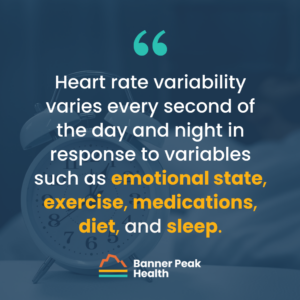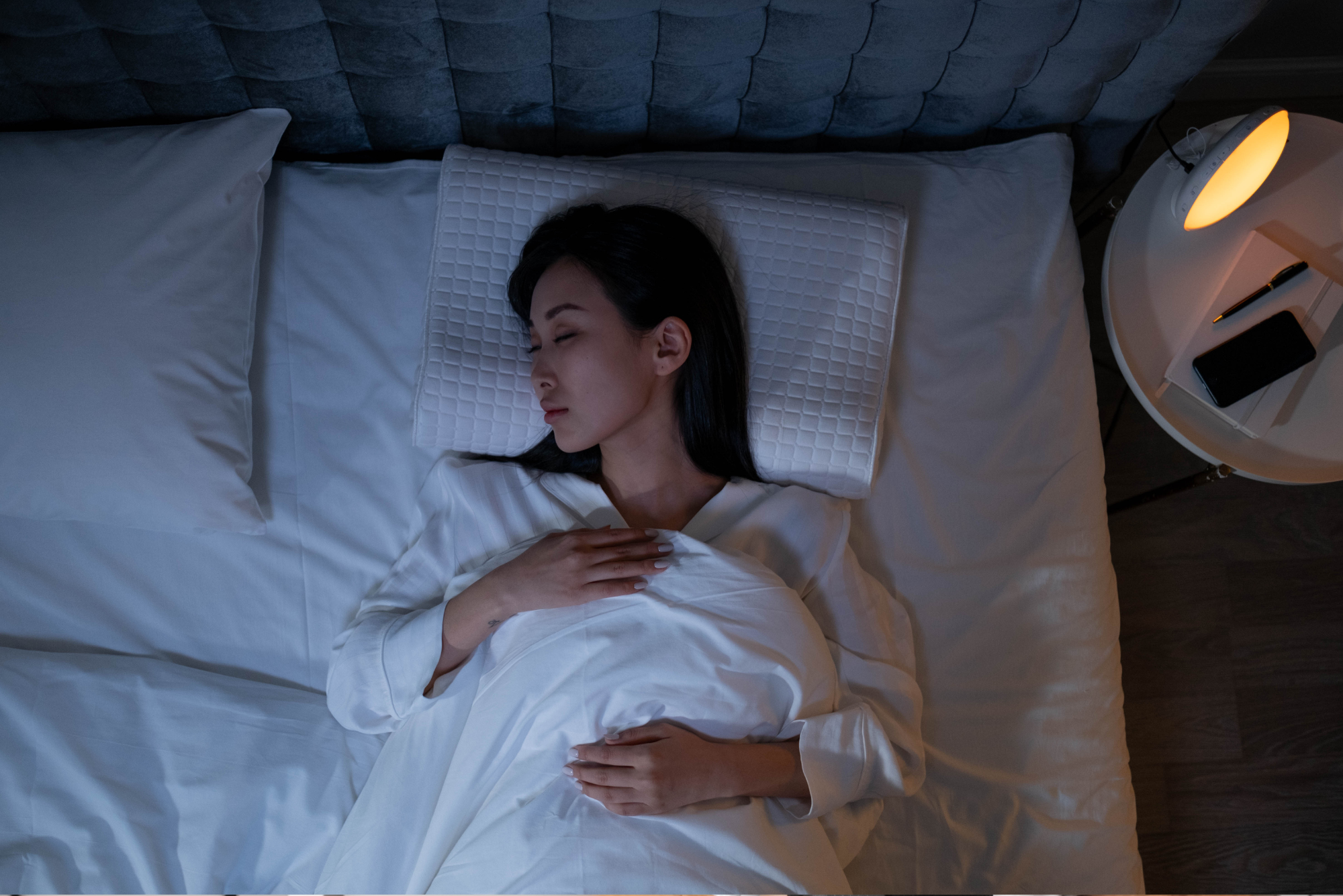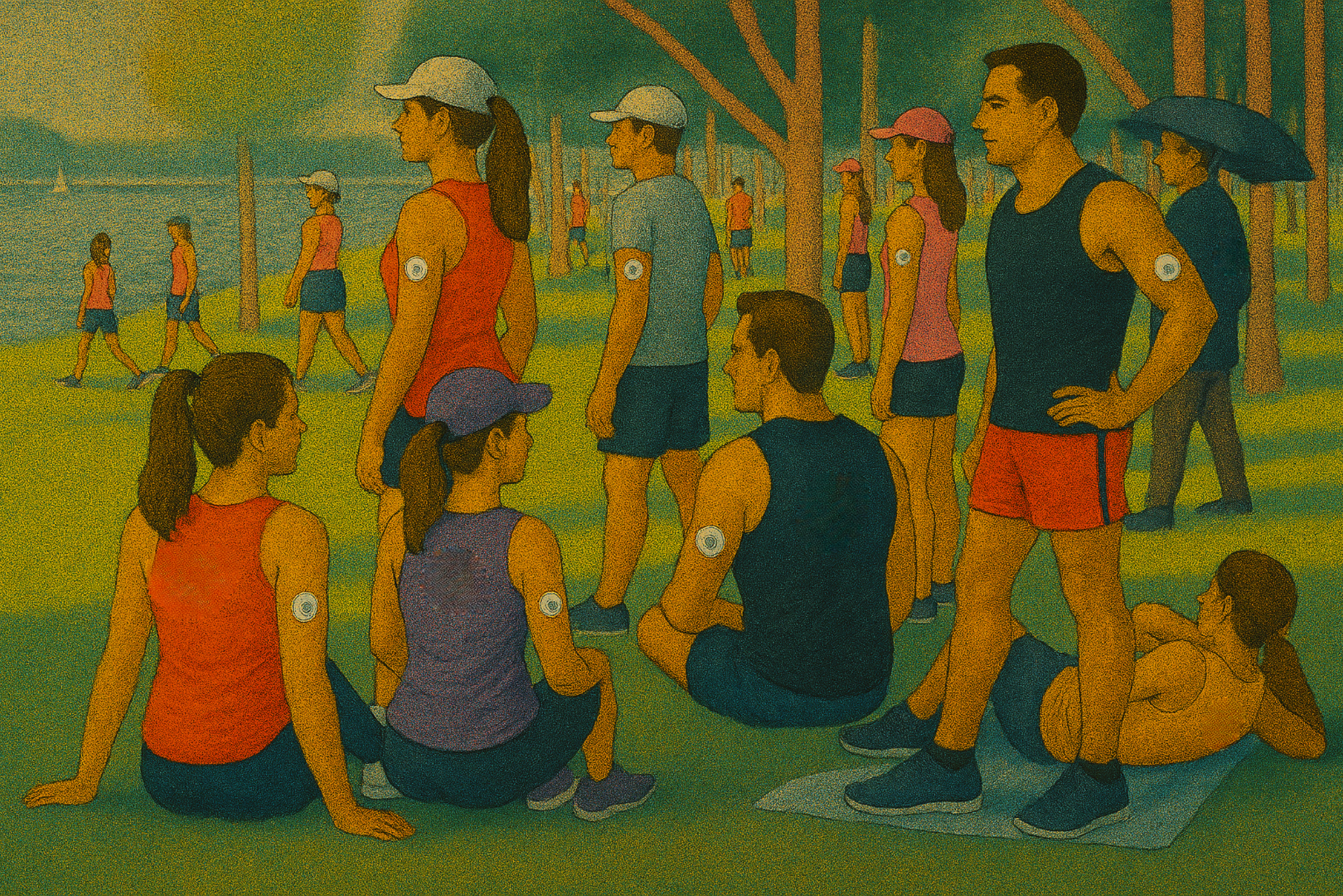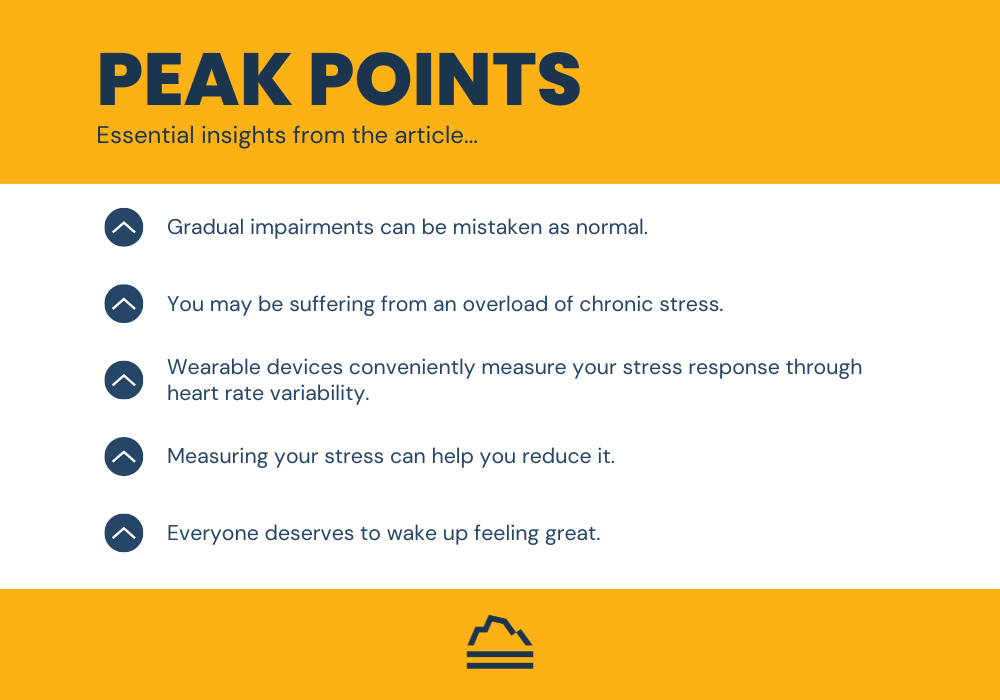
Sometimes, you don’t realize you’re stuck in a rut until your life improves.
Life’s impediments can develop slowly, imperceptibly weighing you down. Your daily experience may be suboptimal, but since you’ve felt that way for many years, you feel normal. Only in retrospect do you realize, Wow! That wasn’t my best self. I can feel so much better!
Many sophisticated tests can measure health status. How about a very simple one — the ability to wake up feeling great?
This blog will review my four-month quest to reach that goal and how I used heart rate variability (HRV) to do it.
How Stress and Heart Rate Variability Relate
I write a lot about stress and its health impacts.
For a risk factor as potent as stress, it’s surprising that we’ve lacked practical methods of measuring it until recently. The growing popularity of wearable devices has finally given us convenient access to this vital metric.
I’ve written about how heart rate variability (HRV) reflects the balance between our sympathetic and parasympathetic nervous systems. More stress increases the sympathetic tone, reducing the variability in timing between each heartbeat. Less stress allows for a greater parasympathetic tone, increasing the timing variability between each heartbeat.
Basically, the higher your heart rate variability, the more “chill” you are.
Recent blogs have illustrated the value of MDECs (Metric-Derived Empowerment Cycles), techniques for generating actionable health data to help people improve their health. Heart rate variability, as measured by wearable devices, is a helpful metric-derived empowerment cycle.
Heart rate variability reflects the sum of physiological and psychological stress sources. Worried about a final exam? Bad night of sleep? Too much (or any) alcohol? Hard workout? Sore back? Laid off from a job? Your heart rate variability will reflect it.
Technically, heart rate variability doesn’t measure the total amount of stress we are exposed to. Rather, it measures how our body reacts to stress — a subtle but important distinction.
Stress is an inevitable part of the human condition. In manageable amounts, it propels us forward, but if its intensity and duration exceed our ability to cope, we suffer adverse consequences. Heart rate variability as a metric-derived empowerment cycle quantifies how our body reacts to our total stress burden. It can also track the results of our stress-management efforts.
Heart Rate Variability’s Role in Fitness
The current abundance of products that measure heart rate variability (Apple Watch, Garmin, Whoop, Oura Ring, etc.) reflects heart rate variability’s popularity in the fitness community. Analyzing daily heart rate variability provides a valuable tool to assist athletes in monitoring their response to training.
A hard workout doesn’t make you stronger, per se; rather, a successful recovery makes you stronger. Knowing your heart rate variability can help you adjust your workouts’ intensity and timing.
For instance, an athlete who wakes up feeling “off” and notices an unusually low heart rate variability score might be better served by scaling back or eliminating a hard workout that day rather than risk overtraining and slowing overall improvement.
While using heart rate variability for sports training may be the primary use case driving its popularity, measuring variation over longer periods of time can guide decisions that affect a wider range of health outcomes.
Short-term stress is adaptive. It helped our ancestors outrun predators. It’s the chronic, elevated stress of modern life that raises our risk for obesity, heart disease, diabetes, cancer, sleep disorders, and mental health conditions. Heart rate variability informs how a person can better cope with stress and reduce the risk of these types of illnesses.
My Stress-Reduction Journey
Over the last year, I’ve experimented with different methods for measuring heart rate variability, including wearables such as Whoop or the Oura Ring and smartphone apps that use a chest strap or the phone camera. How heart rate variability is measured affects its utility.
Heart rate variability varies every second of the day and night in response to variables such as emotional state, exercise, medications, diet, and sleep. For heart rate variability to assess individual variables such as less sugar intake or more exercise, other factors need to be standardized.
A common approach is to measure heart rate variability while asleep, which reduces factors that might interfere with the result. For example, Whoop uses a proprietary algorithm to average the response throughout the night, preferentially calculating heart rate variability during slow-wave sleep, and the Oura Ring records the heart rate variability level every five minutes and presents an average for the night.
I use the Oura Ring because I appreciate its straightforwardness, and I like tracking my heart rate variability throughout the night. My Oura Ring has taught me that chocolate, sugary desserts, and alcoholic beverages impair my sleep and lower my heart rate variability when I consume them close to bedtime. In fact, I can correlate how many hours the effect lasts with how much I consume.1
In general, measuring heart rate variability at night eliminates many influences that occur while we’re awake. However, issues that arise at night, like a sleep disorder, can affect it. As I described in a prior blog, a SleepImage device taught me that I had a mild case of obstructive sleep apnea, which contributed to my reduced heart rate variability.
I also use the app HRV4Training to monitor my heart rate variability daily. Its protocol relies on a one-minute pulse reading through the smartphone camera, done while sitting immediately after waking up. It eliminates the effects of sleep disorders and other factors that come into play once you begin your day.
The Oura Ring has a great feature labeled “unguided session” that monitors your heart rate variability for a predetermined amount of time, allowing you to run experiments and determine their effect on your heart rate variability. I use it to track my physiological response to my 20-minute meditation sessions. My heart rate variability rises two or four times higher than my nighttime values (even after treating my obstructive sleep apnea), confirming my meditation’s efficacy.2
In addition to providing daily feedback, heart rate variability monitoring tracks changes over weeks and months.
In January 2024, I began addressing many years of deferred maintenance in my life. I embarked on an extensive process of physician appointments, lab studies, sleep monitoring, diet modification, therapy, and dietary supplements.
Many of these interventions would be expected to raise my heart rate variability:
- I began taking a fish oil supplement to reduce my cardiovascular risk. Fish oil has been found to have anti-depressant benefits. I hadn’t been suffering from depression, but any mood improvement may raise heart rate variability.
- I included more Zone 2 training in my exercise regime.
- I improved my sleep/wake cycle synchronization using a TUO lightbulb. I now get more sleep and don’t need an alarm.
- I began treating my mild obstructive sleep apnea.
- I reduced my alcohol and sugar consumption.
- I began B12 replacement for borderline low levels.
- I reshaped my work responsibilities as a physician.
- I began adhering more consistently to 20-minute meditation sessions each morning.
- I adopted a “no news after nine” rule to reduce my news consumption.
My monthly average heart rate variability rose a remarkable 25%, from 19 ms in January 2024 to 25 ms in April 2024. This very significant improvement correlates with how much better I feel.
Heart Rate Variability: Final Thoughts
This blog is not a precise prescription for how to feel better. Rather, it’s an example of how HRV monitoring can guide decisions to improve one’s life. For the first time in years, I wake up feeling great.
I want to bring heart rate variability monitoring’s benefits to patients at Banner Peak Health. Reach out to learn how it can help you achieve your health goals.
Footnotes:
- Before my April 6 nocturnal Oura Ring recording, I consumed one glass of wine with dinner. Both my heart rate and heart rate variability were elevated until around 3 a.m., reflecting the increased sympathetic tone associated with processing even a small amount of alcohol. Most nights, I drink no alcohol. For example, the April 11 tracing illustrates a comparably low HRV score from other factors distributed more evenly throughout the night.
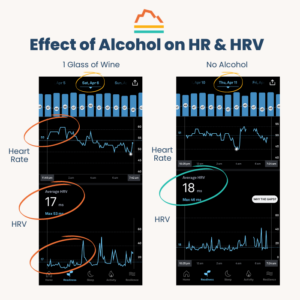 My Oura Ring functions as a biofeedback mechanism, demonstrating my meditation’s physiological impact. This is a tracing of an abbreviated 10-minute meditation session. The average heart rate variability of 84 ms reflects a value fourfold higher than my average nocturnal value for the year. Compared to being asleep, I reach a state four times more chill during meditation, quantitative evidence of its powerful impact!Peripheral skin temperature correlates with heart rate variability. This tracing demonstrates meditation’s impact on peripheral skin temperature, which progressively warms during the session. When we’re nervous (increased sympathetic tone), our hands become cold and clammy. As we calm down, they warm up, reflecting an increased parasympathetic tone. My finger became warmer during the meditation session.
My Oura Ring functions as a biofeedback mechanism, demonstrating my meditation’s physiological impact. This is a tracing of an abbreviated 10-minute meditation session. The average heart rate variability of 84 ms reflects a value fourfold higher than my average nocturnal value for the year. Compared to being asleep, I reach a state four times more chill during meditation, quantitative evidence of its powerful impact!Peripheral skin temperature correlates with heart rate variability. This tracing demonstrates meditation’s impact on peripheral skin temperature, which progressively warms during the session. When we’re nervous (increased sympathetic tone), our hands become cold and clammy. As we calm down, they warm up, reflecting an increased parasympathetic tone. My finger became warmer during the meditation session.
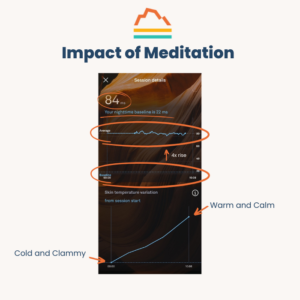

Barry Rotman, MD
For over 30 years in medicine, Dr. Rotman has dedicated himself to excellence. With patients’ health as his top priority, he opened his own concierge medical practice in 2007 to practice medicine in a way that lets him truly serve their best interests.
